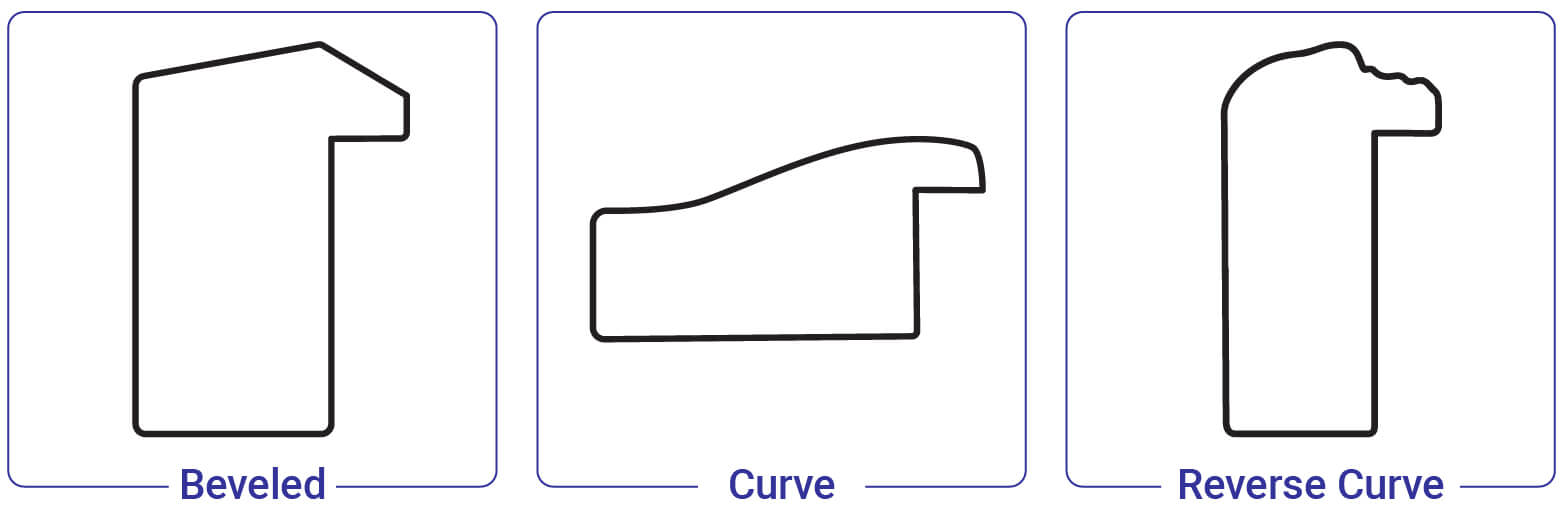Understanding Picture Frame Profiles
We’ve all heard the phrase “form over function.” It pertains to beautifully designed objects that simply don’t work. What’s great about picture frame profiles is that both form and function are working together. Their function is to provide important information about the picture frame such as its width, height, and rabbet width/depth. Their various forms serve as a creative element of the frame’s moulding.
A Little Background on Moulding
Standard picture frames are composed of four pieces of moulding, also spelled molding. Picture frame moulding is a piece of wood or metal that has been shaped into a specific style and features a rabbet for holding the frame’s contents. There are many different styles and colors of picture frames; however, today we are going to talk about how to understand frame profiles.
Picture frame moulding is generally sold to framers in lengths between 7 and 10 feet, which are then chopped to make individual frames. The profile is the outline of a frame moulding’s cross section. (Akin to the profile of a person’s face.) Moulding catalogs typically include an illustration of each moulding profile along with corresponding measurements. We provide an illustration with measurements for each profile on the Frame Destination website.
Why the Variety of Outlines?
When you see these cross-sections by themselves, you might wonder, why the crazy shapes … the bumps, the dips, the leaning lines? Well, frame profiles come in an array of options for a few reasons. So that you can:
1. Choose to complement or heighten the style of your artwork.
2. Enrich the architectural detail of a given space.
3. Accommodate a particular artwork depth or size.
Another reason could be that moulding artisans are creative like you and me, and get bored of the same old frame designs!
Going on a Road Trip
Reading a frame profile is a little like reading a map. Of course, we all know that a map reveals routes to a destination and how many miles it will take to get there. A frame profile informs you of crucial measurements that relate to whether your art, mat, and glazing will fit within that frame. It also reveals the “scenery” in the form of the profile shape. For example, a Beveled profile lends a clean, modern look while a Reverse Scoop profile is much more intricate.

Map “Key” to Illustration Above
Width: Also known as the frame’s “face,” this measurement is the distance from the frame’s lip to its back.
Height. Distance from the heel of the frame to its tallest point. The height also tells you how far the frame will stand out from the wall, which is important if you are displaying art in a space where you are concerned about people bumping into it.
Heel. Bottom edge of the frame farthest away from the artwork.
Lip. The inside edge of a moulding that is equivalent to the rabbet’s width. Pay attention to this measurement if you are framing unmatted artwork because it will determine how much of the art is covered by the frame.
Rabbet. The interior portion of the picture frame; holds the frame’s components, including the glazing, mat(s), artwork, and backing.
Rabbet Height/Depth. This very important measurement tells you how much room is available for the frame’s components.
Rabbet Width. This measurement tells you the width of the underside of the moulding’s lip. As with the frame’s lip, pay attention to this measurement if you are framing unmatted artwork because it will determine how much of the art is covered by the frame.
Common Picture Frame Profiles
Below are some common frame profiles. For each profile, we provide a link to a Frame Destination frame that most closely match each one.





Pairing Art with Picture Frame Profiles
When pairing your artwork with a picture frame, you can use the profile as a guide prior to selecting the color and finish.
• Contemporary frames generally feature a flat, square, triangular, or curved profile and pair well with modern art paintings, posters, and giclee prints.
• Traditional and ornate frames typically have more elaborate stepped, scooped, or sloped profiles. These pair well with fine art paintings or antique photographs.
• L-shaped profiles are designed to hold and showcase gallery-wrapped canvases of specific thicknesses.
ALWAYS check the depth/height of the profile’s rabbet so you can be assured that your artwork will fit inside of the frame.
Now that you have the scoop on picture frame profiles, put your newfound knowledge and DIY skills to work! Any questions? Don’t hesitate to reach out to us. And feel free to share your results with us in the comments below.
Happy framing!
Last Updated February 1, 2025
Written by Joely Rogers
 Joely C. Rogers is an artist/illustrator and writer living in the mountains of western North Carolina. She has professional training in both natural science illustration and the culinary arts, as well as graduate academic training in education, sociolinguistics, and folklore/storytelling. She is a Blue Ridge Naturalist candidate with the North Carolina Arboretum and a member of the Guild of Natural Science Illustrators.
Joely C. Rogers is an artist/illustrator and writer living in the mountains of western North Carolina. She has professional training in both natural science illustration and the culinary arts, as well as graduate academic training in education, sociolinguistics, and folklore/storytelling. She is a Blue Ridge Naturalist candidate with the North Carolina Arboretum and a member of the Guild of Natural Science Illustrators.